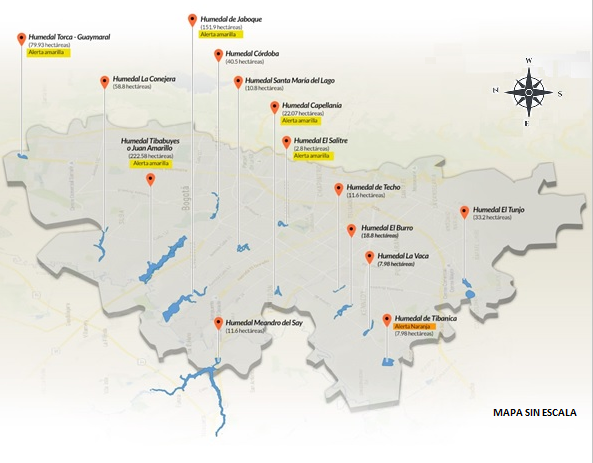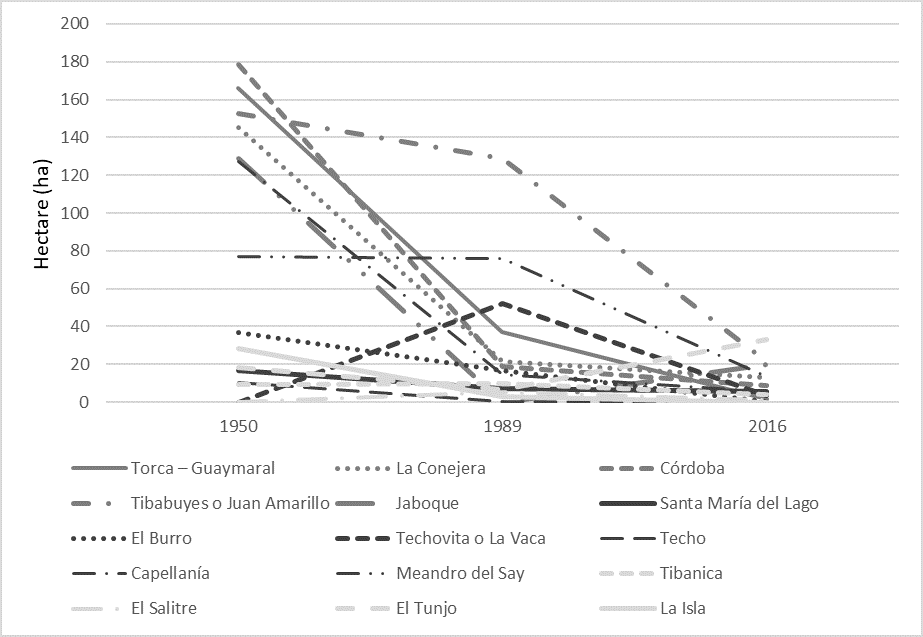I. INTRODUCTION
There are several ways of describing the wetlands. However, the most extensive is the one presented in [1], where the author defined them as “Extensions of marshes, swamps, bogs, or natural or artificial waters, permanent or temporary, stagnant or running, sweet, brackish or salty, including the extensions of sea water with a depth at low tide not bigger than six meters”. Wetlands are formed in places where the phreatic layer is found in the ground surface or near it, or where the land is covered by shallow waters. Wetlands are part of the Earth’s ecosystems that stand out for its biological wealth, its high productivity and biodiversity resembling biological rainforests [2].
According to the Ramsar Convention, wetlands are classified into five great systems according to their biological and physical properties: a) marine: shore wetlands including rocky shores and coral reefs; b) estuarian: deltas, tide marshes, and mangrove swamps; c) lacustrine: lakes; d) riparian: wetlands associated to rivers and streams, and e) marsh: morasses, marshes, and swamps [3].
Following this classification, wetlands found in the city of Bogotá are part of the lacustrine and riparian systems, given their elevation above sea level. Generally speaking, these zones fulfill a hydraulic regulation function by cushioning the effect of the waves, stocking flood waters, holding sediments, and reducing pollution levels; and that is why they are denominated “nature’s kidneys.” [2]
Due to the ecosystem importance of these water bodies, its preservation must be a priority in the territorial ordering politics, but currently the acting of the government parties in charge of their protection has been void. As a consequence, there is a reduction, deterioration, and pollution process [4]. In addition to this, the migration of rural population to big cities, metropolitan areas, and intermediate cities from 1940 to 1990 was approximately 21.3 million people [5] and generated the increasing of the urban use of land and non-controlled settlements around wetlands. This event generated irreparable damages that lead to the complete drying of the water mirror of these ecosystems in order to get urban soil. The aim of this study is to quantify in an explorative way the damaging process of these ecosystems due to drying and construction activities from 1950 to 2016 in Bogota.
II. MATERIALS AND METHODS
An estimation of the wetland area of Bogota in 1950, 1989, and 2016 was made through the review of geographic information from the Agustín Codazzi Geographical Institute (IGAC) and the Aqueduct and Sewer Bogotá Company (EAAB). The information was digitized with the help of AutoCAD software in order to perform the analysis of the area variation of these water bodies in the city. Figure 1 shows the location of the wetlands in Bogota– the ones included in the study.
III. RESULTS
After the information related to the selected wetlands was collected, the most relevant data was put in Table 1. The results allowed us to estimate the alterations on the water mirror area of each ecosystem, as an aftermath of the construction processes. The table also includes the consulted sources in which the information of the city’s wetlands is compiled.
Table 1 Estimation of the water mirror area loss in hectares (ha) from wetlands known by the Environment District Secretary between 1950, 1989 y 2016.
| Wetland | Basin | Location | Water Mirror Area | Lost Area (%) | Source | |||||
| 1950 | 1989 | 2016 | 1950-1989 | 1950-2016 | ||||||
| Torca-Guaymaral | Torca | Usaquén Suba | 166.03 | 36.89 | 1.50 | 77.78 | 99.10 | [7] | ||
| La Conejera | Conejera | Suba | 145.02 | 21.59 | 13.16 | 85.11 | 90.93 | [8] | ||
| Córdoba | Salitre | Suba | 178.45 | 18.78 | 8.82 | 89.47 | 95.06 | [9] | ||
| Tibabuyes o Juan Amarillo | Salitre | Suba Engativá | 152.56 | 128.83 | 21.39 | 15.59 | 85.98 | [10] | ||
| Jaboque | Jaboque | Engativá | 128.62 | 113.17 | 20.02 | 12.01 | 84.43 | [11] | ||
| Santa María del Lago | Salitre | Engativá | 16.47 | 7.29 | 5.64 | 55.74 | 65.75 | [12] | ||
| El Burro | Fucha | Kennedy | 36.66 | 16.91 | 0.20 | 53.88 | 99.45 | [13] | ||
| Techovita o La Vaca | Fucha | Kennedy | - | 51.94 | 3.37 | - | - | [14] | ||
| Techo | Fucha | Kennedy | 10.32 | 0.49 | - | 95.28 | - | [15] [16] | ||
| Capellanía | Fucha | Fontibón | 127.23 | 14.75 | 5.84 | 88.40 | 95.41 | [17][18] | ||
| Meandro del Say | Fucha | Fontibón | 77.19 | 76.20 | 13.60 | 1.29 | 82.38 | [19] | ||
| Tibanica | Tunjuelo | Bosa | 9.18 | 10.01 | 3.79 | +9.04 | 58.71 | [20] | ||
| El Salitre | Salitre | Barrios Unidos | - | 5.59 | 1.30 | - | - | [21] [22] | ||
| El Tunjo | Tunjuelo | Tunjuelito Ciudad Bolívar | 18.50 | 6.78 | 33.20 | 63.34 | +79.45 | [23] [24] | ||
| La Isla | Tunjuelo | Bosa | 28.28 | 3.04 | - | 89.25 | - | [23][25] | ||
IV. ANALYSIS
According to the available data collected and analyzed in this study, the behavior of the wetland areas in the city of Bogota on 1950, 1989 and 2016 shows an average decrease of 84,52% in width, except for the wetland located in “El Tunjo”, which grew 79,45%. This shows that the protection measures were implemented too late, and a considerable portion of these ecosystems rich in flora and fauna and necessary for the cushioning and storing of flood waters has been lost [2].
Wetlands are of fundamental ecological importance [26] because they perform a vital part in several phenomena and natural processes [27]. Therefore, different problems such as floods in non-planned settlements, migration or disappearing of endemic species, morphological changes, and displacement of wet zones, arise when wetlands are drained and dried.
The need to have institutional buildings and infrastructure has been the common denominator of urban settlement since the first half of the 20th century; thus, the construction of housing through informal land occupation has happened gradually. This process has happened without the correct evaluation of the environmental impact on the land and has damaged the ecosystems to the point of desiccating. Furthermore, one of the main factors that contributes to the pollution of wetlands is the disposal of contaminated waters that affects their delicate chemical balance [28].
When analyzing the loss of area in the Bogota wetlands, it is evident that construction is one of the causes for the disappearance or decrease of these bodies of water. Furthermore, despite the lack of conservation of the wetlands, they have not been completely extinguished.
These hydraulic regulatory ecosystems fulfill the important function of balancing and buffering floods [2] [29]. Therefore, the reduction of its area represents both an ecological and a security threat in the city, and to prevent it, it is necessary to implement public policies that advocate the rescue and conservation of wetlands. It is important to keep in mind that social and environmental interaction have a specific effect on human actions [30], and these ought to be a source of feedback because protecting urban ecosystems is as fundamental as conserving wetlands.
V. CONCLUSIONS
The decrease of the wetlands in the city of Bogota is directly related to the human settlements occurring during the second half of the 20th century because they located around water bodies. Also, the care of wetlands was inexistent to the point of almost desiccating them due to the need to supply the population with infrastructure and basic sanitation.
The protection and preservation of the Bogota wetlands during the second half of the last century has not been as effective. An average of almost 84% of these water bodies has been completely dried, so the city would not have these ecosystems 20 years from now, had the city government not decreed the care of these water bodies [31].
The hydraulic capacity of wetlands is one of their fundamental characteristics and shows the conformation of new wetland areas after uncontrolled construction desiccated those existing. Therefore, the planimetric translation is a visible evidence of the need for these ecosystems to buffering the river floods.

















